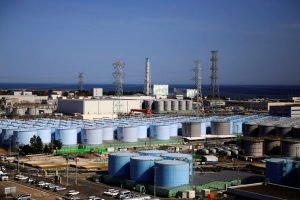Japanese officials are abandoning past goals of cutting back the country’s reliance on nuclear power, and planning to develop ‘next-generation reactors’, in a plan to meet ambitious new clean energy goals.
Nuclear power has remained on the backseat in Japan since the Fukushima disaster in 2011 brought scrutiny to the safety practices in the industry.
But increasing concerns around energy security and a goal to cut carbon emissions to net zero by 2050, has brought nuclear power back to Japan’s energy policy.
Also on AF: Russian Tankers Sink in Black Sea, US Warns on ‘Dark Fleet’
Japan’s industry ministry wants nuclear energy to meet 20% of Japan’s electricity needs by fiscal year 2040, according to a draft of a revised basic energy policy.
While that is in line with the 2030 target of between 20% and 22%, the new plan removes the previous target of “reducing reliance on nuclear power as much as possible”.
It also includes plans to build innovative next-generation reactors at nuclear power sites owned by operators who have decided to decommission existing reactors.
“The government has finally realised that nuclear power is important because it can provide the country with affordable energy and stable load, and data centres need energy 24/7,” said Naomi Oshita, a power market associate with Wood Mackenzie’s Asia Pacific power and renewables team.
“Nuclear power and data centres go well together,” Oshita added.
In the years since Fukushima, Japan slashed its reliance on nuclear power and increased the use of fossil fuels to generate 70% of its electricity.

But having faced coal and gas price spikes and supply disruptions in 2022 due to Russia’s war on Ukraine, the government wants to lock in greater use of nuclear energy to secure stable energy supply.
Meeting growing electricity demand with nuclear power, however, will be challenging for Japan due to regulatory hurdles, public opposition, high costs, severe earthquakes and long development timeframes.
Experts say the country is likely to fall short of its 2030 target for nuclear power due to public resistance and slow regulator approvals. Adding new nuclear capacity would also be difficult considering can take decades to build nuclear plants, they say.
Nuclear power accounted for 8.5% of the country’s power supply in 2023.
Unclear policy on coal, wind power
Officials are also aiming for renewable energy to account for up to 50% of its electricity mix by 2040.
That would be roughly double the 22.9% share of renewables in the 2023 fiscal year and exceed the 2030 target of between 36% and 38%.
But advocates for renewable energy have criticised the draft, noting the lack of a roadmap for phasing out coal-fired power.
Thermal power usage, particularly from inefficient coal-fired power plants, is set to decrease to between 30% and 40% of the mix by 2040 from 68.6% in 2023, But the draft energy policy does not specify the breakdown of coal, gas and oil.
Mika Ohbayashi, a director at the Renewable Energy Institute, also pointed to the small target share for wind power, between 4% and 8%, compared with 20% for nuclear. That could leave Japan lagging in wind power compared with other markets worldwide.
Still, the new proposed energy plan is more realistic than the existing targets through 2030, some analysts say, indicating that the government wants to attract investments in renewable energy, including storage batteries, and keep LNG as a transition fuel.
The draft also called for the government and the private sector to secure long-term LNG contracts to hedge against price hikes and supply disruption risks.
“It is necessary to utilise LNG-fired power as a realistic means of transition,” it said.
The energy plan, which is revised every three years, is expected to be finalised and approved by the cabinet early next year.
- Reuters, with additional editing and inputs from Vishakha Saxena
Also read:
Energy Emissions Set to Peak But ‘Not in Time’ For Climate Goals
Asian Steelmakers Failing on Shift to Renewables, Survey Finds
Hope Grows China Emissions May Have Peaked – or Will Next Year
Asian Economies at Risk From Inaction on Climate Change: ADB
Fossil Fuels Set to Drive Global Emissions to a Record, Yet Again
Scientists Say 2024 ‘Virtually Certain’ to be Hottest on Record
Indonesia’s Prabowo Vows to Close Coal Plants in 15 Years
Emissions of World’s Super Rich ‘Drive Economic Losses, Deaths’
What Will Donald Trump Mean For Global Carbon Markets?
























